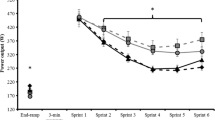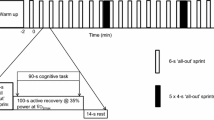Abstract
In addition to a high aerobic fitness, the ability to buffer hydrogen ions (H+) may also be important for repeated-sprint ability (RSA). We therefore investigated the relationship between muscle buffer capacity (βmin vivo and βmin vitro) and RSA. Thirty-four untrained females [mean (SD): age 19 (1) years, maximum oxygen uptake (V̇O2peak) 42.3 (7.1) ml·kg−1·min−1] completed a graded exercise test (GXT), followed by a RSA cycle test (five 6-s sprints, every 30 s). Capillary blood was sampled during the GXT and before and after the RSA test to determine blood pH (pHb) and lactate concentration ([La−]b). Muscle biopsies were taken before (n=34) and after (n=23) the RSA test to determine muscle lactate concentration ([La−]i), hydrogen ion concentration ([H+]i) pHi, βmin vivo and βmin vitro. There were significant correlations between work decrement (%) and βmin vivo (r=−0.72, P<0.05), V̇O2peak (r=−0.62, P<0.05), lactate threshold (LT) (r=−0.56, P<0.05) and changes in [H+]i (r=0.41, P<0.05). There were however, no significant correlations between work decrement and βmin vitro, or changes in [La−]i, or [La−]b. There were also no significant correlations between total work (J·kg−1) during the RSA test and βmin vitro, βmin vivo, or changes in [La−]i, pHi, [La−]b, or pHb. There were significant correlations between total work (J·kg−1) and both V̇O2peak (r=0.60, P<0.05) and LT(r=0.54, P<0.05). These results support previous research, identifying a relationship between RSA and aerobic fitness. This study is the first to identify a relationship between βmin vivo and RSA. This suggests that the ability to buffer H+ may be important for maintaining performance during brief, repeated sprints.

Similar content being viewed by others
References
Bassett DR. Howley ET (2000) Limiting factors for maximum oxygen uptake and determinants of endurance performance. Med Sci Sports Exerc 32:70–84
Bishop D, Jenkins DG, Mackinnon LT (1998) The relationship between plasma lactate parameters, W peak and 1-h cycling performance in women. Med Sci Sports Exerc 30:1270–1275
Bishop D, Spencer M, Duffield R, Lawrence S (2001) The validity of a repeated sprint ability test. J Sci Med Sport 4:19–29
Bishop D, Lawrence S, Spencer M (2003) Predictors of repeated-sprint ability in elite female hockey players. J Sci Med Sport 6:199–209
Bishop D, Davis C, Edge J, Goodman C (2004) Induced metabolic alkalosis affects muscle metabolism and repeated-sprint ability. Med Sci Sports Exerc 36:807–813
Bogdanis GC, Nevill ME, Boobis LH, Lakomy HKA (1996) Contribution of phosphocreatine and aerobic metabolism to energy supply during repeated sprint exercise. J Appl Physiol 80:876–884
Chin ER, Allen DG (1998) The contribution of pH-dependent mechanisms to fatigue at different intensities in mammalian single muscle fibres. J Physiol (Lond) 512:831–840
Coyle EF, Feltner ME, Kautz SA, et al (1991) Physiological and biomechanical factors associated with elite endurance cycling performance. Med Sci Sports Exerc 23:93–107
Dawson B, FitzSimons M, Ward D (1993) The relationship of repeated sprint ability to aerobic power and performance measures of anaerobic work capacity and power. Aust J Sci Med Sport 25:88–93
Edge J, Bishop D, Goodman C, Dawson B (2002) The effects of training intensity on muscle buffer capacity and repeated-sprint ability. European Congress of Sport Science, Athens, Greece, p 622
Fabiato A, Fabiato F (1978) Effects of pH on the myofilaments and the sarcoplasmic reticulum of skinned cells from the cardiac and skeletal muscles. J Physiol (Lond) 276:233–255
FitzSimons M, Dawson B, Ward D, Wilkinson A (1993) Cycling and running tests of repeated sprint ability. Aust J Sci Med Sport 25:82–87
Fornasiero D, Martin DT, Brosnan MJ, et al (1999) Effects of altitude training on repeat sprint and graded exercise test performance in female road cyclists. Fifth IOC World Congress on Sport Sciences, p 90
Gaitanos GC, Williams C, Boobis LH, Brooks S (1993) Human muscle metabolism during intermittent maximal exercise. J Appl Physiol 75:712–719
Gore CJ, Hahn AG, Aughey RJ, et al (2001) Live high:train low increases muscle buffer capacity and submaximal cycling efficiency. Acta Physiol Scand 173:275–286
Harris C, Edwards RHT, Hultman E, Nordesjo LO, Nylind B (1976) The time course of phosphorylcreatine resynthesis during recovery of the quadriceps muscle in man. Pflugers Arch 367:137–142
Harris RC, Hultman E, Nordesjo LO (1974) Glycogen, glycolytic intermediates and high-energy phosphates determined in biopsy samples of musculus quadriceps femoris of man at rest: methods and variance of values. Scand J Clin Lab Invest 33:109–120
Hermansen L (1981) Muscle fatigue during maximal exercise of short duration. In: Prampero PE di, Poortmans J (eds) Physiological chemistry of exercise and training. medicine and sport science. Karger, Basel, pp 45–52
Holloszy JO, Coyle EF (1984) Adaptations of skeletal muscle to endurance exercise and their metabolic consequences. J Appl Physiol 56:831–838
Hultman E, Sahlin K (1980) Acid-base balance during exercise. Exerc Sport Sci Rev 8:41–128
Ivy JL, Costill DL, Maxwell BD (1980) Skeletal muscle determinants of maximum aerobic power in man. Eur J Appl Physiol 44:1–8
Juel C (1998) Skeletal muscle Na+/H+ exchange in rats: pH dependency and the effect of training. Acta Physiol Scand 164:135–140
Kowalchuk JM, Heigenhauser GJF, Lindinger MI, Obminski G, Sutton JR, Jones NL (1988) Role of lungs and inactive muscle in acid-base control after maximal exercise. J Appl Physiol 65:2090–2096
Krustup P, Mohr M, Amstrup T, et al (2003) The yo-yo intermittent recovery test: physiological response, reliability and validity. Med Sci Sports Exerc 35:697–705
Larson-Meyer DE, Newcomer BR, Hunter GR, Joanisse DR, Weinsier RL, Bamman MM (2001) Relation between in vivo and in vitro measurements of skeletal muscle metabolism. Muscle Nerve 24:1665–1676
Mannion AF, Jakeman PM, Willan PLT (1993) Determination of human skeletal muscle buffer value by homogenate technique: methods of measurement. J Appl Physiol 75:1412–1418
McCully KK, Kakihira H, Vandenborne K, Kent-Braun J (1991) Noninvasive measurements of activity-induced changes in muscle metabolism. J Biomech 21 [Suppl 1]:153–161
McCully KK, Fielding RA, Evans WJ, Leigh JS, Posner JD (1993) Relationships between in vivo and in vitro measurements of metabolism in young and old human calf muscles. J Appl Physiol 75:813–819
McMahon S, Wenger HA (1998) The relationship between aerobic fitness and both power output and subsequent recovery during maximal intermittent exercise. J Sci Med Sport 1:219–227
Nevill ME, Boobis LH, Brooks S, Williams C (1989) Effect of training on muscle metabolism during treadmill sprinting. J Appl Physiol 67:2376–2382
Sahlin K, Henriksson J (1984) Buffer capacity and lactate accumulation in skeletal muscle of trained and untrained men. Acta Physiol Scand 122:331–339
Sjödin B, Jacobs I, Svedenhag J (1982) Changes in onset of blood lactate accumulation and muscle enzymes after training at OBLA. Eur J Appl Physiol 49:45–57
Takahashi H, Inaki M, Fujimoto K, Katsuta S, Anno I, Niitsu M, Itai Y (1995) Control of the rate of phosphocreatine resynthesis after exercise in trained and untrained human quadriceps muscles. Eur J Appl Physiol 71:396–404
Walter G, Vandenborne K, McCully KK, Leigh JS (1997) Noninvasive measurement of phosphocreatine recovery kinetics in single human muscles. Am J Physiol 272:C525–C535
Westerblad H, Bruton J, Lannergren J (1997) The effect of intracellular pH on contractile function of intact, single fibres of mouse declines with increasing temperature. J Physiol (Lond) 500:193–204
Weston AR, Wilson GR, Noakes TD, Myburgh KH (1996) Skeletal muscle buffering capacity is higher in the superficial vastus than in the sloeus of spontaneously running rats. Acta Physiol Scand 157:211–216
Weston AR, Myburgh KH, Lindsay FH, Dennis SC, Noakes TD, Hawley JA (1997) Skeletal muscle buffering capacity and endurance performance after high-intensity interval training by well-trained cyclists. Eur J Appl Physiol 75:7–13
Author information
Authors and Affiliations
Corresponding author
Rights and permissions
About this article
Cite this article
Bishop, D., Edge, J. & Goodman, C. Muscle buffer capacity and aerobic fitness are associated with repeated-sprint ability in women. Eur J Appl Physiol 92, 540–547 (2004). https://doi.org/10.1007/s00421-004-1150-1
Accepted:
Published:
Issue Date:
DOI: https://doi.org/10.1007/s00421-004-1150-1




